In his travels, Darcy Rhyno has come upon many cloistered spaces where people throughout the ages have sought serenity.
It was while writing a short story that the word first came to me. I’d taken my protagonist Julie back to her rented cottage where she’s retreated after separating from her husband. The cottage is in her hometown, a village in Nova Scotia. It’s the first time she’s been back since she moved to Calgary after university.
It’s winter. She ventures into town, but can’t bring herself to look up old friends or talk to strangers. She returns to her cottage, closing the door behind her and leaning against it. That’s when I found myself writing, “The room gathered round her, cloistral in its silence.”
I’d never used the word “cloistral” before. Was I using it correctly? Was “cloistral” even a word? A quick check with the dictionary reassured me that I was and it was. In fact, once the word was there, doing its work in that sentence, I couldn’t imagine removing or replacing it. I couldn’t have chosen a better word to express precisely Julie’s physical position and emotional condition.
Since the moment I first used the word, I’ve been exploring “cloister” as an idea – as a state of mind, as an historical concept, as an architectural and mental construction and, like Julie, as an emotional condition. On recent trips I took in 2010 to Britain and Spain, I got to explore the cloister as a physical space.
Barcelona
The streets of Barcelona were crowded, hot and loud with shoppers, on a typical morning last summer when my partner and I happened upon an open doorway we’d not seen before on the way from our hotel room. We peeked inside… a courtyard… a church. A single pepper tree dropped ripe, red peppercorns onto the cobblestones, adding spice to the heat of the courtyard. A man sold flowers from a small stand. We followed those who bought his flowers into the church where a woman arranged them in vases around the room. Inside the church, it was dark, cool. A small service for half a dozen elderly people was underway. We sat quietly, the stares of a few turned heads making us feel like intruders.
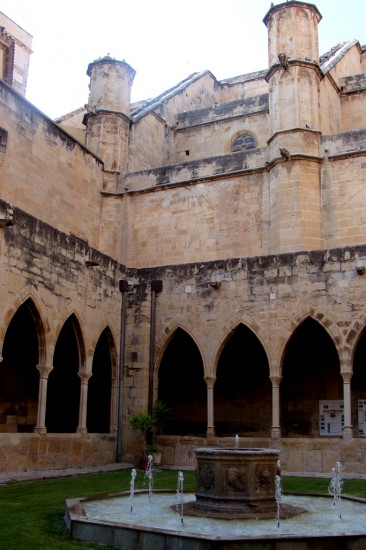 When the service ended, we explored further, pushing through a heavy, wooden door at the back of the church. It led to a cloister as small as a room, but without a roof, a reminder that the word “cloister” has its origins in the Latin, claustrum, for “enclosure”. In fact, the origins of the Christian cloister can be traced directly to the Greek and Roman architectural feature called a peristyle or roofed porch around an open courtyard off a house, often with an interior garden. Even our present day concept of a “yard” has its roots there. The stone walls of that little cloister in the heart of Barcelona felt enclosed, protected, a barrier against the noise, the pace and the relentlessness of the consumerism ruling the streets just on the other side of the wall, but for the moment as far away as another time.
When the service ended, we explored further, pushing through a heavy, wooden door at the back of the church. It led to a cloister as small as a room, but without a roof, a reminder that the word “cloister” has its origins in the Latin, claustrum, for “enclosure”. In fact, the origins of the Christian cloister can be traced directly to the Greek and Roman architectural feature called a peristyle or roofed porch around an open courtyard off a house, often with an interior garden. Even our present day concept of a “yard” has its roots there. The stone walls of that little cloister in the heart of Barcelona felt enclosed, protected, a barrier against the noise, the pace and the relentlessness of the consumerism ruling the streets just on the other side of the wall, but for the moment as far away as another time.
Wales
A kilometer from the village of Llangollen in northern Wales lies the 800-year-old ruins of Valle Crucis Abbey. It’s a lonely place, the isolation intensified by the bare, rusted hills against which the Abbey appeared in relief as we approached along the road. Once the retreat for a thriving abbey of perhaps 100 monks, today, the cloister is nothing more than a square of green grass and a bench against the sunny stone wall of the church behind. The main purpose of Medieval cloisters like this one was to form a solid barrier between the monks and the laymen who worked in other parts of the monastery.
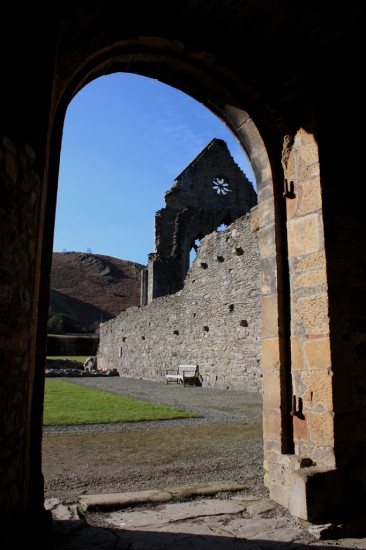 But as I sat on that bench on a cold March day with the snowbells blooming in patches all around, the sun on my face was proof that monks commonly built cloisters against southern walls for a reason. Southern exposure was good for the plants and trees of the carefully tended gardens within. In their day, cloisters were not sown with grass and mowed. They were indeed enclosed gardens or, in latin, hortus conclusus.
But as I sat on that bench on a cold March day with the snowbells blooming in patches all around, the sun on my face was proof that monks commonly built cloisters against southern walls for a reason. Southern exposure was good for the plants and trees of the carefully tended gardens within. In their day, cloisters were not sown with grass and mowed. They were indeed enclosed gardens or, in latin, hortus conclusus.
England
A few days later under looming skies in north Yorkshire, we drove into a natural cloister formed of the surrounding hills to the ruins of Rievaulx Abbey. Walking among the half crumbled walls to the south of the church itself, I imagined a bustling place full of monkish activity – shepherding, gardening, cooking, eating, building, praying… and resting in the cloister. In Aelred’s treatise on friendship from roughly 1160, it’s possible to imagine that the cloister was reminiscent for the monks of the Garden of Eden or perhaps of the promise of a better life after this one, for Aelred wrote of the moment he stepped inside, “[at] the delights of paradise with the leaves, flowers and fruits of each single tree I marvelled.”
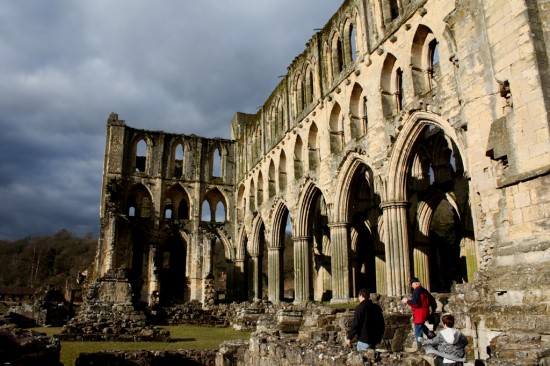 Or perhaps he was thinking metaphorically of the hortus conclusus at Rievaulx for the Virgin Mary herself was referred to a closed garden, her womb untouched and protected by a wall from sin. Many late Medieval and early Renaissance painters placed her in or beside a walled garden or yard. Life, a cultivated garden, protected and nurtured inside.
Or perhaps he was thinking metaphorically of the hortus conclusus at Rievaulx for the Virgin Mary herself was referred to a closed garden, her womb untouched and protected by a wall from sin. Many late Medieval and early Renaissance painters placed her in or beside a walled garden or yard. Life, a cultivated garden, protected and nurtured inside.
Poblet
Every hour, a guide leads visitors inside the Poblet monastery, one of Spain’s many UNESCO World Heritage Sites and like all the others, Cistercian. Carefully opening a door, the guide ushers us into the cloister before locking it again behind us. We hear the babble of water, the only sound but for the echo of footfalls on stone. A working well. A working monastery. In Poblet, there are no ruins.
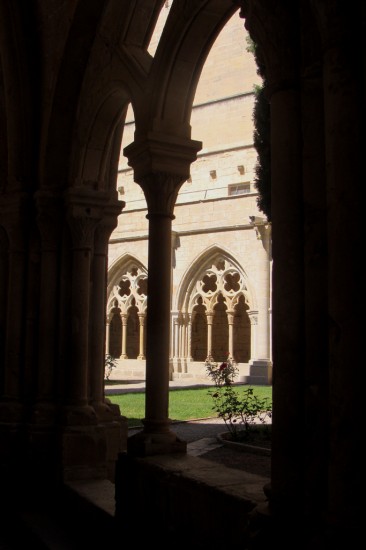 Many of the cloisters I visited in the past year had wells like the one in Poblet or the remains of wells for the watering of gardens and as an expression of belief in both the delicacy and persistence of life. Water, the breath of life for gardens so ephemeral, all traces vanish from abandoned cloisters long before the architecture, the art, the literature or the music, each created with just as much care and granted equal metaphorical weight.
Many of the cloisters I visited in the past year had wells like the one in Poblet or the remains of wells for the watering of gardens and as an expression of belief in both the delicacy and persistence of life. Water, the breath of life for gardens so ephemeral, all traces vanish from abandoned cloisters long before the architecture, the art, the literature or the music, each created with just as much care and granted equal metaphorical weight.
The Backyard
It was a shock after touring the quiet Valle Crucis Abbey in Wales to discover hidden on the other side of a mound a park stuffed with caravans, but it also underscored the need for cloisters, then and now… there and here. It was after trips to Spain and Britain in 2010 that I came to understand in a new way why I live where I live, on 15 acres down a long driveway off a dirt road on the edge of what barely qualifies as a village in rural Nova Scotia, our house surrounded on three sides by forest. As within a cloister, this is where we plant and tend gardens – always with southern exposure – and feel somehow removed from the outside world, walled and protected from sin.
I returned home to discover that in one corner of the yard, we had without fully understanding, built ourselves a cloister. My partner planted a circle of flowerbeds, had me dig out the sod and put down mulch to keep the weeds at bay and to warm this sunny corner in our cool seaside climate. We planted a hedge of eight-foot-high perennial sunflowers to wall her space off from the forest behind. Our son built her a bench, which she added to the existing table and chairs. She set potted plants all around and keeps a watering can handy. It’s where she goes to be alone, where the yard gathers around her, cloistral in its silence.
Photo Credits
D Rhyno in cloister, Poblet © Darcy Rhyno. All Rights Reserved.
Cloister in Tortosa Spain © Darcy Rhyno. All Rights Reserved.
Rievaulx Abbey, England © Darcy Rhyno. All Rights Reserved.
Cloister at Valle Crucis Abbey © Darcy Rhyno. All Rights Reserved.
Clositer Poblet, Spain © Darcy Rhyno. All Rights Reserved.
Cloistered Yard © Darcy Rhyno. All Rights Reserved.

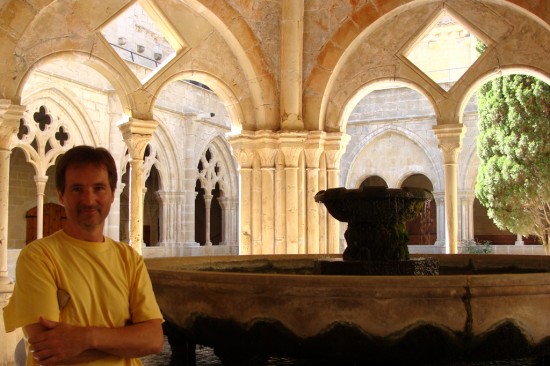


Please Share Your Thoughts - Leave A Comment!